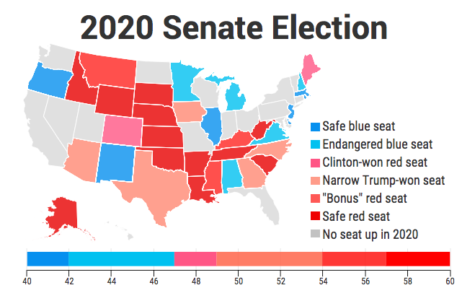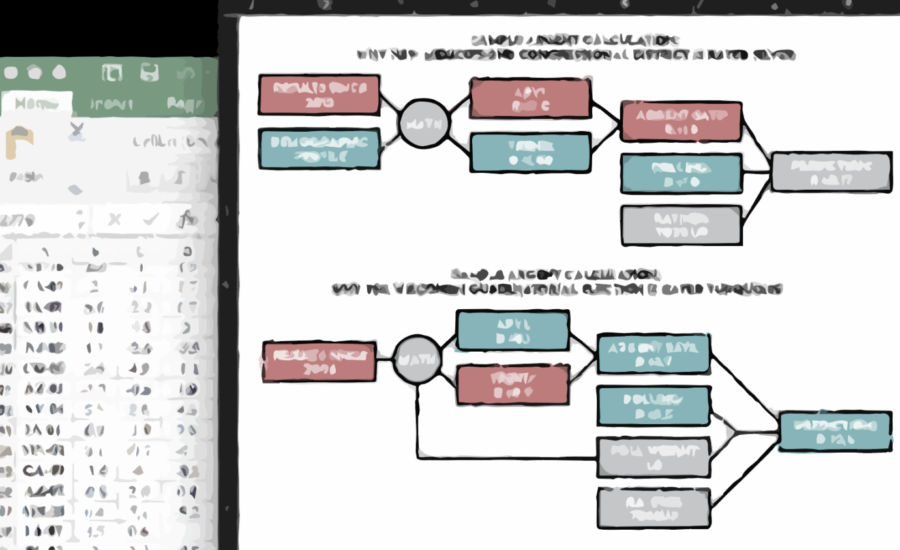Midterm Madness V: What’s Next?
What 2018 tells us about the Democrats’ 2020 strategy
The conversation about the Democrats’ strategy to take on Trump in 2020 is centered on two types of swing states: the rust belt and the sun belt. Rust belt swing states (Minnesota, Wisconsin, Michigan, Pennsylvania, Ohio, Iowa) are more traditional swing states which, until 2016, had a slight Democratic lean to them. These states have large amounts of white blue-collar workers and shifted significantly from Obama to Trump.
Democrats performed rather well in most of these states in 2018. Democrats won almost every major contest in this region with two exceptions: the governorships of Ohio and Iowa. The former suggests that Ohio is headed the way of Missouri, which used to be a critical swing state but is now ruby-red. The latter sends a more mixed message, since Democrats won three out of four congressional districts in Iowa even though all four voted for Trump. But it is important to remember that these states are still trending towards Republicans.
On the other side of America, sun belt swing states (Florida, Virginia, North Carolina, Georgia, Arizona, New Mexico, Texas) are slightly less traditional swing states which have been trending towards Democrats in recent years. Democrats have already converted New Mexico and Virginia into blue states, and in 2018 they started to do so in Arizona. However, Democrats have been slightly less successful in the rest of those states. North Carolina, which is basically a 50-50 state at this point, is a hot mess of gerrymandering and voter suppression. Florida, despite several disappointments for Democrats in 2018, may lean more Democratic in 2020 due to the passage of Amendment 4, which restored voting rights to felons in Florida. And while Democrats haven’t flipped Texas or Georgia yet, they made some progress in 2018.
In Midterm Madness III, I alluded to how 2018 could inform the 2020 election if there were a pattern in the Obama-Trump districts or the Romney-Clinton districts. Democrats only lost two of the 15 Romney-Clinton districts while they lost six of the 18 competitive Obama-Trump districts.
In short, 2018 showed that both strategies have merit and problems. Democrats’ victories in the rust belt indicate that the states Trump relied on to win the electoral college (Michigan, Wisconsin, Pennsylvania) are ripe for picking for the Democrats. At the same time, Democrats’ close margins and occasional flips in the sun belt show that in several of these states (Arizona in particular), partisan gravity is working on the Democrats’ side.

The 2020 Senate election. Colors indicate who controls the Senate seat up in 2020, and how competitive it could be. States in gray do not have a Senate election in 2020.
So… Kamala or Biden?
Beside where to campaign, the question remains: Who should be the one campaigning? Most of the big names for 2020 fall into one of two categories of my invention: the WMDs (whites, men and *Blue Dogs) like Joe Biden and the NLWs (non whites, liberals and women) like Kamala Harris. This election year sent a mixed message about which one is the more effective candidate.
*A Blue Dog is a euphemism for a moderate or conservative Democrat
On the one hand, the enigmatic effect of Beto O’Rourke in Texas and Stacey Abrams in Georgia showed that the NLWs may be better at gathering energy, but those two still lost. At the same time, NLW candidates featured in some of the Democrats’ most impressive House flips in 2018, such as Lucy McBath in GA-06 and Lauren Underwood in IL-14.
On the other hand, WMDs had a rather successful night in the midwest. Democratic senators cruised to reelection in Michigan, Wisconsin, Pennsylvania, Ohio, West Virginia and Minnesota, and the governorships in Michigan and Wisconsin were flipped by candidates that were more WMD than NLW. However, 2016 showed that white moderates don’t have the same type of energy behind them as liberals, such as Bernie Sanders, or PoCs, such as President Barack Obama.
The question remains which matters more to 2020 Democratic primary voters: rising energy or actual results? The answer to this question will likely determine the answer to the rust belt vs. sun belt conundrum.
Can Democrats take the Senate in 2020?
Democrats need to pick up four seats to take the Senate in 2020, three if they also win the presidency. Democrats have a path to accomplishing this, and although it will be simpler than in 2018, it won’t be easy.
Starting on the left, Democrats are defending 12 Senate seats, five of which could be considered competitive: Alabama, New Hampshire, Michigan, Minnesota and Virginia. Of all of these, only Doug Jones in Alabama is in serious danger from the start.
Next are Republican seats in states Clinton won: Colorado and Maine. While Susan Collins of the latter used to enjoy a moderate record and a sky-high approval rating, her vote for Kavanaugh took a serious toll on her reelection prospects in Maine. It’s too soon to say how the race will play out, but it will certainly be closer than in 2014 when she won with 69 percent of the vote.
After that are Republican seats in states Trump narrowly won: Arizona, North Carolina, Georgia, Texas and Iowa. The first on that list is the special election to fill the late John McCain’s seat. The appointed incumbent, John Kyl, has resigned and will be replaced by Martha McSally, the GOP’s nominee for the Arizona Senate race in 2018. After Democrat Kyrsten Sinema beat McSally in 2018 to pick up Jeff Flake’s seat, Democrats may be feeling optimistic about their chances of taking both Arizona Senate seats, especially since they already beat McSally once. The other four aren’t as easy for Democrats, but most of them will be highly competitive. Texas and Georgia could become toss ups very quickly if Beto O’Rourke and Stacey Abrams return after their narrow 2018 defeats.
Finally, there is a bonus category for Democrats: Montana, Mississippi and Kentucky. Montana regularly elects Democrats statewide, and should Democratic Governor Steve Bullock choose to run against Steve Daines in 2020, it would instantly become a competitive race. Kentucky, on the other hand, rarely elects Democrats statewide, but having a senator as unpopular as Senate Majority Leader Mitch McConnell is also quite rare. So depending on who Democrats pick, Kentucky could be in play. Mississippi could get ugly fast if Republican Cindy Hyde Smith, who recently won a special election, gets embroiled in a bitter primary due to numerous controversial statements about race. In total, Republicans will be defending 22 seats.
To recap, Democrats will be defending roughly five competitive seats while Republicans will be defending as many as 10. Democrats’ likeliest path to taking the Senate would be if they won the presidency—gaining the tie-breaking vice president vote—won all of the seats they currently control except for Alabama, and then took Maine, Colorado, Arizona and North Carolina. Those last two I mention because, of all the narrow Trump states, they are the most likely to vote Democrat for president in 2020.
Surprise surprise I am talking about states again
The next step for Democrats is the 2019 elections. While it is an off year, a couple Southern states hold local elections in the year after midterms. First on the agenda for Democrats is the Virginia legislatures. Due to Democratic gains in the Assembly in 2017 and a likely redrawing of the gerrymandered State Assembly map, Democrats are within striking distance of taking both chambers. Also at stake are the Louisiana governorship, where Democrats are playing defense, and the Kentucky and Mississippi governorships, where Democrats smell upset opportunities.
In 2020, Democrats have a chance to pick up state legislatures in Arizona, Michigan, Wisconsin, Florida, Pennsylvania, North Carolina, Iowa and Minnesota. Of those, only Florida and North Carolina are critical to preventing another round of GOP gerrymandering, since the rest have Democratic governors who can veto partisan maps or have systems in place to prevent gerrymandering. A dark horse to keep an eye on is the Texas House of Representatives, which went from 95-55 Republican to 82-68 Republican in 2018.
The next round of gerrymandering
Although the congressional GOP gerrymanders in some states were beaten by Democrats in 2018, the legislative gerrymandering weren’t. Democrats won more votes than Republicans yet failed to take the legislature in Michigan, Wisconsin, Pennsylvania and North Carolina in 2018. However, these gerrymanders could be redrawn along with their federal counterparts if 2020 goes well.
Already, it looks like the GOP gerrymanders in Michigan, Wisconsin, Virginia and Pennsylvania will be gone in 2021. If Democrats do well in 2019 and 2020, they could also eliminate the GOP gerrymanders in Louisiana, North Carolina and Florida. With those seven gone, the biggest GOP gerrymanders would be Texas, Georgia and Ohio (the latter will be slightly dampened by a ballot initiative passed last year called Issue 1).
A cap off to Midterm Madness
Even though Midterm Madness is done, the madness in Washington is by no means finished. If you want to read more about the topics I have discussed, follow Daily Kos elections writer Stephen Wolf at @PoliticsWolf or read articles from my sources: cookpolitical.com, centerforpolitics.org/crystalball and fivethirtyeight.com/politics.
That’s all folks! You can also look back on the previous four installments of Midterm Madness right here:












